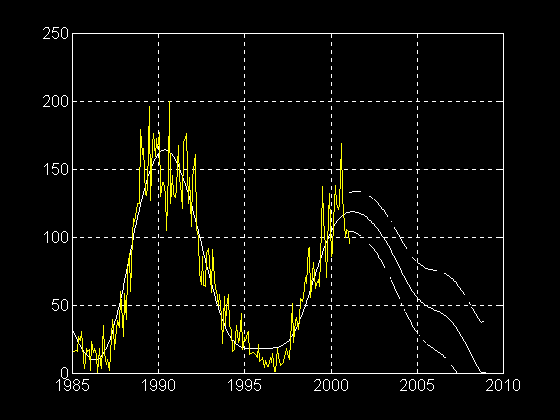Solar Activity Prediction Service
(Bulgarian-Russian Project)
Authors: Boris Komitov and Vladimir Kaftan

The Extremal Phases of 23rd Solar Cycle
Today the future solar activity is a great interest not only for scientific
investigations of processes at the Sun but for many branches of a humane activity
too. The knowledge of a future Sun behavior is very significant particularly
with space-related activities and communication means The
causes of this significance are a danger for space flights and a
disturbance for radio wave propagation due to solar flares and magnetic
storms accompanied to periods of a highest sol
ar activity. These ionosphere
disturbances can be causes for the reducing of an accuracy of precise
positioning with the use of the Global Satellite Navigation Systems.
The connection between the above mentioned humane activity spheres and
the solar activity is more or less understandable.
But there are many practical and scientific fields where these relations are
hypothetical though they seem to be quite plausible. The examples can be a
human health or a weather condition. A rigorous functional dependence between
hem and the solar activity is not determined in spite of a long time
of researches. In any cases it is quite obvious that people have to be
interested in the solar b
ehavior both current and future. Therefore the
authors of this web pages are making their modest attempt to help somebody in
this problem.
Two methods of analysis of the long-therm variations of solar activity / the Schove's series / are used : the T-R periodogramm analysis and the method, which is used by V.Kaf
tan

The T-R correlogramm of Schove's series /1000-1996 AD/. The main cycle is at T=210 years.

The Schove's series : Spectra of variations by using the method of V.Kaftan.
The plots bellow show the tendency of the solar activity in the future nearest decades. A new supercenturial solar minimum is clear shown . It is determined from Schove's series by using of the both abovementioned methods..

A. On the base of T-R analysis

B. By using the method of V.Kaftan

The forecast of the second half of the current 11 year solar cycle. This is a result of the analysis of the monthly mean International sunspot number Ri values obtained from 1750 to 2000 AD.
The paper of B.Komitov and V.Kaftan in the International Journal of Geomagnetism & Aeronomy (click here)
See also for additional information






�